DOI:
10.1039/C4RA07651F
(Paper)
RSC Adv., 2014,
4, 51787-51793
Retracted Article: Equilibrium and kinetic studies on adsorptive removal of malachite green by the citrate-stabilized magnetite nanoparticles
Received
26th July 2014
, Accepted 26th September 2014
First published on 29th September 2014
Abstract
The present study investigated the adsorptive removal of malachite green (MG) from aqueous solution by using the citrate-stabilized magnetite nanoparticles (NPs). Magnetite NPs were synthesized chemically by precipitation method and they were characterized by XRD, TEM, particle size analyzer and zeta potential measurement. The mean diameter and zeta potential of the NPs was determined to be 25 nm and −33.14 mV, respectively. The adsorption of MG on the magnetite NPs was fitted better to Freundlich than Langmuir model. Kinetics of adsorption follows pseudo-second order rather than pseudo-first-order kinetic model. The pH of the interaction medium influenced the adsorption process. The adsorption of MG on the iron oxide NPs was decreased upon the increase of pH values. The rate of adsorption decreased with the increase of NaCl concentration in interaction medium. The present study may be applied for large scale to remove the dye stuffs from industrial effluents.
1. Introduction
The textile industries produce more amounts of liquid effluents, because an immeasurable amount of water is used in the dying process.1 Azo dyes are commercially used in textile industries because of their cost effectiveness and availability.2 These compounds are difficult to decompose because of their complex chemical structure and stability.3 Several methods including chemical oxidation, coagulation/flocculation, photocatalysis, and microbiological or enzymatic degradation have been reported previously for the treatment of dye bearing effluents,4–6 but they are generally inefficient for the complete removal of dyes. Adsorption removal of dyes using some solid material is the method of choice for the treatment of waste water.7,8 Introduction of nanotechnology has overcome the problem associated with these materials. In recent years the polymer stabilized iron oxide NPs has been utilized for the removal of different pollutants from the waste water.9–11 Besides the considerable advantages, the polymer stabilized NPs suffer some drawbacks like higher cost, and water solubility of polymer leads to aggregation of NPs and lack of reusability. The present study overcomes these drawbacks by utilizing citrate-stabilized iron oxide NPs for the efficient removal of textile dyes. Iron oxide NPs have a super paramagnetic property, as they are attracted to magnetic field, but after removal of magnetic field, no extra magnetism is retained. This property makes iron oxide nanoparticles acceptable for removal of pollutants as compared to nonmagnetic nanoparticles.12
Malachite green (MG) is a cationic dye widely used in various industries such as a food coloring agent, dying of leather, silk and wool, paper and distilleries.13 MG has carcinogenic, genotoxic, and various other toxic properties, because of the presence of a nitrogen group,14,15 but still MG is utilized in various industries due to its low cost, good stability and lack of alternatives.16 In addition improper disposal of dyes leads to reduction in sunlight penetration that causes a decrease in photosynthetic activity.16,17 Therefore, it is very necessary to remove the wastewaters containing these dyes prior to discharge into the environment.
2. Materials and method
2.1. Materials
MG was obtained from Otto kemi Industries, Mumbai. Ferric Chloride (FeCl3·6H2O), ferrous Chloride (FeCl2·4H2O), ammonia and tri sodium citrate were obtained from Merck (Darmstadt, Germany). Conical flasks and beakers were obtained from Borosil, India.
2.2. Preparation of magnetite nanoparticle
The solution of ferric chloride and ferrous chloride were mixed in the molar ratio of 2![[thin space (1/6-em)]](https://www.rsc.org/images/entities/char_2009.gif) :
:![[thin space (1/6-em)]](https://www.rsc.org/images/entities/char_2009.gif) 1. The solution was maintained for 1 h stirring at 80 °C after mixing. Then, the temperature was increased to 90 °C and 30% ammonia solution (50 mL) was added to the mixture. 50 mL of tri sodium citrate (0.3 M) was added to the above prepared solution as a stabilizing agent, and the solution was left for 1 h in the stirrer. The precipitate was then washed twice with de-ionized water and lyophilized.
1. The solution was maintained for 1 h stirring at 80 °C after mixing. Then, the temperature was increased to 90 °C and 30% ammonia solution (50 mL) was added to the mixture. 50 mL of tri sodium citrate (0.3 M) was added to the above prepared solution as a stabilizing agent, and the solution was left for 1 h in the stirrer. The precipitate was then washed twice with de-ionized water and lyophilized.
2.3. Characterization of nanoparticle
UV-vis-NIR spectrometer (Perkin Elmer, lambda-750) was employed to determine the oxidation state of the formed iron oxide NPs. The morphology and size of iron oxide nanoparticles were observed by transmission electron microscopy (Jeol JEM- 2100F field emission electron microscope, Japan). The particles were also subjected to X-ray diffraction analysis using a Bruker AXS, diffractometer D8, Germany. The target was Cu Kά. (λ = 1.54 A°). The generator was operated as 45 kV and with 30 mA current. The scanning range (2θ) was selected from 10° to 100°. Furthermore, the particles were subjected to zeta potential measurement and particle size analysis using Malvern instruments, U.K.
2.4. Effect of pH on adsorption
The effect of pH on the adsorption of MG on the iron oxide NPs was studied at different pH (4–10). The pH was adjusted using 0.1 M HCl or 0.1 M NaOH. MG solution (250 mg L−1) was interacted with the iron oxide NPs (5 mg) for 2 h in an orbital shaker at 150 rpm. The samples were centrifuged at 10![[thin space (1/6-em)]](https://www.rsc.org/images/entities/char_2009.gif) 000×g for 30 min, and the amount of MG left in supernatant was calculated using visible spectrophotometer (Equiptronics; visible spectrophotometer, double beam) by measuring the absorbance at 619 nm.
000×g for 30 min, and the amount of MG left in supernatant was calculated using visible spectrophotometer (Equiptronics; visible spectrophotometer, double beam) by measuring the absorbance at 619 nm.
2.5. Effect of NaCl concentration on adsorption
The effect of salt concentration on adsorption of MG on NPs was studied at different NaCl concentrations (0.01 mM–2 M). Dye (250 mg L−1) and NPs (5 mg) were interacted for 4 h in an orbital shaker at 150 rpm. Thereafter, the samples were centrifuged, and the amount of dyes left in supernatant was calculated.
2.6. Effect of different adsorbent dosage on adsorption
The effect of different adsorbents dosage on adsorption was evaluated by interacting the different amounts of NPs (1–10 mg) with 250 mg L−1 of MG solution for 4 h in an orbital shaker at 150 rpm. The sample was centrifuged, and the amount of dye left in supernatant was calculated.
2.7. Adsorption studies
Isothermal study was carried out with different concentrations of MG (0–250 mg L−1) with 5 mg of NPs, and shaking for 4 h. The final volume was maintained as 50 mL. Langmuir and Freundlich models were used to analyze the equilibrium adsorption data. Langmuir's isotherm states the monolayer adsorption of dyes and the Freundlich's model considers multilayer of adsorption. Equilibrium adsorption was calculated by using the following equation:| |
 | (1) |
where C0 (mg L−1) is the initial dye concentration, Ce (mg L−1) is the amount of dye left after the interaction, qe is the amount of dye adsorbed at equilibrium, V is the volume in L and W (mg) is the weight of the nanoparticles used for adsorption.
Adsorption kinetics was carried out by interacting 5 mg of the iron oxide NPs with an initial concentration of 250 mg L−1 MG up to 96 h. At various time intervals the interaction mixture was centrifuged at 10![[thin space (1/6-em)]](https://www.rsc.org/images/entities/char_2009.gif) 000×g for 20 min. The supernatant was collected, and the amount of dye left in supernatant was determined. The amount of adsorption was calculated at time t, qt (mg mg−1) by the following equation:
000×g for 20 min. The supernatant was collected, and the amount of dye left in supernatant was determined. The amount of adsorption was calculated at time t, qt (mg mg−1) by the following equation:
| |
 | (2) |
where
C0 (mg L
−1) is the initial dye concentration,
Ct (mg L
−1) is the amount of dye left at time
t,
qt is the amount of dye adsorbed at equilibrium at time
t,
V is the volume of solution in
L and
W (mg) is weight of nanoparticles used.
2.8. Regeneration studies
For desorption studies, 5 mg of NPs were interacted with 250 mg L−1 of MG, and the particles loaded with the dye were collected. The interaction volume was maintained as 50 mL. Thereafter, the collected particles was further interacted with 5 mL of 0.01 M NaOH solution, and desorption efficiency for them was calculated.
3. Results and discussion
3.1. Characterization of NPs
UV-vis-NIR spectrometry indicates the formation of the Fe3O4 NPs, which show a peak in the NIR region which starts from 800 nm (Fig. 1a). A transmission electron microscope was employed to analyze the morphology of the magnetite NPs, and the NPs were found to be spherical and oval in shape (Fig. 1b). The mean diameter was found to be 25 nm (Fig. 1c). The zeta potential was determined to be −33.14 ± 1.34. The XRD pattern (Fig. 1d) of synthesized Fe3O4 NPs showed their polycrystalline nature. The peak position at 2θ values of 30.3°, 34.4°, 43.1°, 53.6°, 56.2° and 62.9° are indexed to (220), (311), (400), (422), (511) and (440), respectively. The results obtained agree with standard magnetite (Fe3O4) XRD patterns and identified that the Fe3O4 NPs were in a cubic spinel structure.
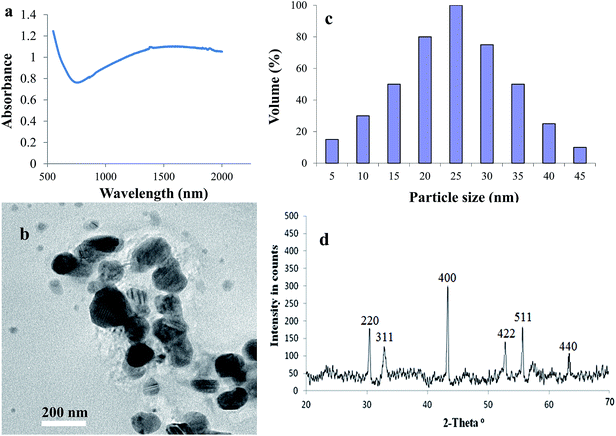 |
| | Fig. 1 Characterization of iron oxide NPs. (a) UV-vis-NIR spectra, (b) particle size distribution, (c) transmission electro microscopic image and (d) XRD pattern of the iron oxide NPs. | |
3.2. Effect of pH on adsorption
The pH of the dye solution plays a valuable role in the entire adsorption process. To determine the optimum pH condition for MG on to the magnetite NPs, the effect of pH on adsorption is investigated in the range of different pH (4–10) with a fixed initial concentration (100 mg L−1). The adsorption of MG on the iron oxide NPs was decreased with increase in pH of the interaction medium (Fig. 2). Afkhami and Moosavi18 studied the adsorptive removal of congo red using the maghemite nanoparticles. They found that maximum adsorption of congo red observed at pH 3 remained constant up to pH 5 and decreased at higher pH values.
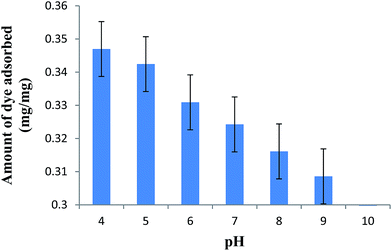 |
| | Fig. 2 Effect of pH on adsorption of MG on iron oxide NPs. | |
3.3. Effect of NaCl concentration on adsorptive removal
Adsorptive removal of dye in the presence of NaCl is also important because the amount of salt present in wastewater is in high concentration. The results showed that the adsorption decreased with the increase in concentration of NaCl (Fig. 3). The reason may be major competitive adsorption, or the attraction between positive MG ions and negative surface decreased. Studies of Saha et al.19 observed the similar trend when they used silver impregnated TiO2 for the removal of MG.
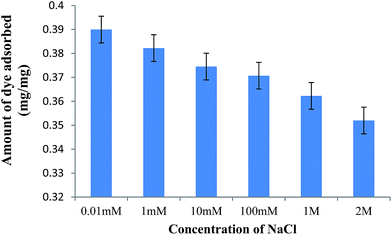 |
| | Fig. 3 Effect of NaCl concentration on adsorption of MG on iron oxide NPs. | |
3.4. Effect of various adsorbent doses on adsorption
The amount of different adsorbent dosages significantly influence the amount of dyes adsorbed. Adsorptive removal of MG by the iron oxide NPs was calculated by interacting different concentration of NPs (1 mg–10 mg L−1) with 250 mg L−1 of dye. The percentage removal of dye increased with increase in the amount of NPs (Fig. 4). Ghaedi et al.20 reported that by increasing the amount of the adsorbent, adsorptive capacity and surface area of adsorbent significantly increased, thereby increasing the adsorption process.
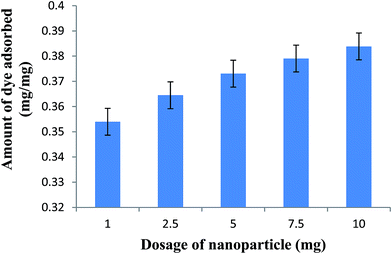 |
| | Fig. 4 Effect of different absorbent doses on adsorption of MG on iron oxide NPs. | |
3.5. Adsorption isotherms
For the adsorption process, study of adsorption isotherms is essential to attain information about disposition of interaction of solute and adsorbent, and it is important to design the adsorption system. The Freundlich model assumes multilayer adsorption and expresses that dye concentration on adsorbent will increase as there is an increase in dye concentration in interaction medium. Our experimental data fitted well with Freundlich isotherm model, suggesting multilayer adsorption of MG onto the surface of the magnetite NPs. The Freundlich equation can be expressed as follows:where Ce is concentration of dye left in supernatant after interaction with the nanoparticle (mg L−1), qe is the amount of dye adsorbed at equilibrium, KF is Freundlich constant. The linear form of Freundlich equation can be expressed as:| |
 | (4) |
In the Langmuir adsorption isotherm, intermolecular forces decline rapidly with distance and predict monolayer inclusion of adsorbate on the outer surface of the adsorbent. The Langmuir equation is expressed as follows:
| |
 | (5) |
where
Ce is the amount of dye left in the supernatant (mg L
−1),
qe is the amount of dye adsorbed at equilibrium,
qmax is maximum amount of dye on the nanoparticle to form the monolayer, and
Ka is the adsorption constant (L mg
−1). The linear form of the Langmuir equation is:
| |
 | (6) |
The constants qmax and Ka were calculated from the intercepts and the linear plot slope of Ce/qe versus Ce. The Langmuir isotherm constants were also manually calculated (Table 1). The large variations between the graphical solution and analytical solutions indicated that the experimental data did not fit well in the Langmuir model (Fig. 5) (Table 1). The plot of (Ce/qe) versus Ce for MG gives a straight line with a correlation coefficient of 0.529, whereas the plot of log![[thin space (1/6-em)]](https://www.rsc.org/images/entities/char_2009.gif) qe versus log
qe versus log![[thin space (1/6-em)]](https://www.rsc.org/images/entities/char_2009.gif) Ce gives a straight line with a correlation coefficient of 0.978. The lower R2 value (regression coefficients) indicates that adsorption process should be better represented by the Freundlich isotherm rather than the Langmuir model (Table 1). Afkhami et al.21 synthesized SDS coated iron oxide NPs, and that followed monolayer of adsorption. The present study used the citrate-stabilized magnetite NPs and that followed multilayer of adsorption and indicates the applicability of these NPs in effluent treatment.
Ce gives a straight line with a correlation coefficient of 0.978. The lower R2 value (regression coefficients) indicates that adsorption process should be better represented by the Freundlich isotherm rather than the Langmuir model (Table 1). Afkhami et al.21 synthesized SDS coated iron oxide NPs, and that followed monolayer of adsorption. The present study used the citrate-stabilized magnetite NPs and that followed multilayer of adsorption and indicates the applicability of these NPs in effluent treatment.
Table 1 Langmuir and Freundlich model parameters for MG adsorption isotherms on the iron oxide NPs
| Adsorbent |
Langmuir isotherm model |
Freundlich isotherm model |
| qmax (mg mg−1) |
ka (L mg−1) |
R2 |
KF (mg mg−1) (L mg−1)1/n |
n |
R2 |
| MG |
0.704 |
0.075 |
0.529 |
0.045 |
1.159 |
0.978 |
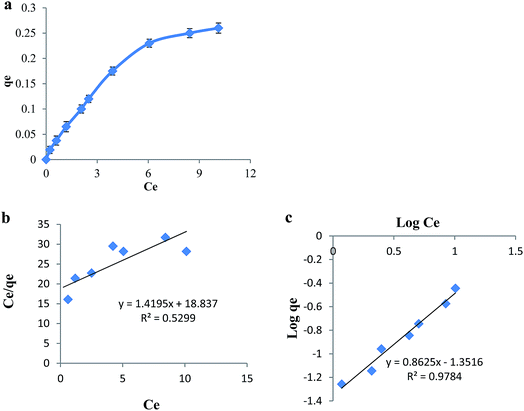 |
| | Fig. 5 (a) The adsorption of MG on the iron oxide NPs at equilibrium, (b) Langmuir isotherm model plotted as a function of Ce/qe versus Ce and (c) Freundlich isotherm model plotted as a function of log![[thin space (1/6-em)]](https://www.rsc.org/images/entities/char_2009.gif) qe versus log qe versus log![[thin space (1/6-em)]](https://www.rsc.org/images/entities/char_2009.gif) Ce for the adsorption of MG on the iron oxide NPs. Ce for the adsorption of MG on the iron oxide NPs. | |
3.6. Adsorption kinetics
The effect of contact time on adsorption of MG onto the magnetite NPs investigated initial dye concentration of 250 mg L−1, and the result is shown in Fig. 6a. Two kinetic models, pseudo-first-order22 and pseudo-second-order23 equations, were used. The pseudo-first-order kinetic equation can be expressed as:| |
 | (7) |
where qe is the amount of dye adsorbed at equilibrium, qt is the amount of dye adsorbed at time t, and k1 is rate constant which can be calculated from the straight line plot of log(qe − qt) versus time (h).
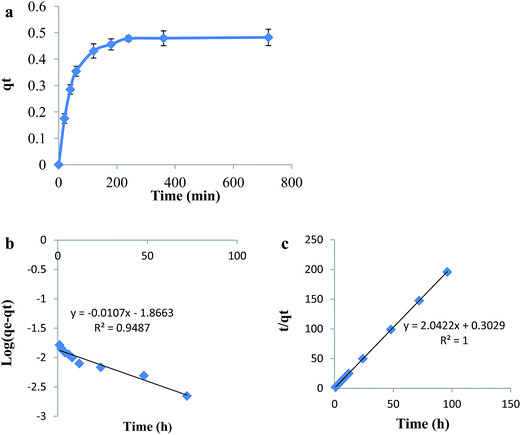 |
| | Fig. 6 (a) The kinetics of adsorption of MG on the iron oxide NPs, (b) Pseudo-first-order kinetics plotted as a function of log(qe − qt) verses time (h) and (c) Pseudo-second-order kinetics plotted as a function of t/qt versus time (h) for the adsorption of MG on the iron oxide NPs. | |
The pseudo-second-order kinetic equation is expressed as:
| |
 | (8) |
The second order rate constant K2 and qe values were determined from the slopes and intercepts. R2 value indicates the linear relation of t/qt versus time (h). The correlation coefficients (R2) of MG for the pseudo first order and pseudo second order models were 0.948 and 1, respectively (Fig. 6b and c). The calculated values of qe from the pseudo first order reaction do not give reasonable value and are too low compared to the pseudo-second order reaction (Table 2). The results suggest that pseudo second order kinetic data is fitted well, indicating the chemisorptions of MG onto NPs.
Table 2 Pseudo-first-order and second-order kinetic model of MG adsorption on the iron oxide NPs
| Adsorbent |
qe (exp) (mg mg−1) |
Pseudo-first-order kinetic model |
Pseudo-second-order kinetic model |
| K1 (min−1) |
qe (cal) (mg mg−1) |
R2 |
K2 (min−1) |
qe (cal) (mg mg−1) |
R2 |
| MG |
0.49 |
0.004 |
0.0136 |
0.948 |
13.806 |
0.489 |
1 |
3.7. Regeneration studies
Desorption is an important process in adsorption studies. It helps the recycling of the adsorbent for further studies. High alkaline pH of the interaction medium inversely influenced the dye adsorption. The collected particles loaded with dye were further interacted with 5 mL of 0.01 M NaOH solution, and desorption efficiency for them was calculated as 97%. Therefore, the particles could be recovered after the adsorption process by changing the pH of the solution to higher alkaline range.
4. Conclusion
The present study shows the adsorptive removal of azo dye and MG using the magnetite NPs. Magnetite NPs have been characterized using TEM, XRD and Zeta sizers. The effect of pH, NaCl and different adsorbent doses were examined. The results indicated that the adsorption data fitted well to Freundlich isotherm rather than Langmuir isotherm. Kinetics of adsorption was almost rapid and best described by pseudo-second-order kinetic model. The citrate-stabilized magnetite NPs showed very good reproducibility and reusability. Therefore, it is concluded that the citrate-caped magnetite NPs can be successfully utilized for the removal of azo dyes from waste water.
List of abbreviations
| MG | Malachite green |
| NPs | Nanoparticles |
| XRD | X-ray diffraction |
| TEM | Transmission electron microscopy |
| mV | Milli volt |
| M | Molarity |
| Mg | Milli gram |
| L | Liter |
| Nm | Nanometer |
| NaCl | Sodium chloride |
| H | Hours |
| Min | Minutes |
Acknowledgements
Authors sincerely thank SASTRA University, Thanjavur for providing TR Rajagopalan grant to carry out the research work.
References
- S. M. A. G. U. de Souza, L. C. Peruzzo and A. U. A. de Souza, Numerical study of the adsorption of dyes from textile effluents, Appl. Math. Model., 2008, 32, 1711–1718 CrossRef PubMed.
- R. A. Schnick, The impetus to register new therapeutants for aquaculture, Prog. Fish-Cult., 1988, 50, 190–196 CrossRef.
- A. S. Alzaydien, Adsorption of methylene blue from aqueous solution onto a low-cost Natural jordanian Tripoli, Am. J. Environ. Sci., 2009, 5, 197–208 CrossRef CAS.
- G. Mezohegyi, F. P. van der Zee, J. Font, A. Fortuny and A. Fabregat, Towards advanced aqueous dye removal processes: A short review on the versatile role of activated carbon, J. Environ. Manage., 2012, 102, 148–164 CrossRef CAS PubMed.
- A. Arunarania, P. Chandran, B. V. Ranganathan, N. S. Vasanthi and S. S. Khan, Bioremoval of Basic Violet 3 and Acid Blue 93 by Pseudomonas putida and its adsorption isotherms and kinetics, Colloids Surf., B, 2013, 102, 379–384 CrossRef PubMed.
- S. Sudheer Khan, A. Arunarani and P. Chandran, Biodegradation of Basic Violet 3 and Acid Blue 93 by Pseudomonas putida, Clean: Soil, Air, Water, 2013, 41, 1–6, DOI:10.1002/clen.201200676.
- V. K. Gupta Suhas, Application of low-cost adsorbents for dye removal – A review, J. Environ. Manage., 2009, 90, 2313–2342 CrossRef PubMed.
- K. Deepa, P. Chandran and S. Sudheer Khan, Bioremoval of Direct Red from aqueous solution by Pseudomonas putida and its adsorption isotherms and kinetics, Ecol. Eng., 2013, 58, 207–213 CrossRef PubMed.
- P. Xu, G. M. Zeng, D. L. Huang, C. Lai, M. H. Zhao, Z. Wei, N. J. Li, C. Huang and G. X. Xie, Adsorption of Pb(II) by iron oxide nanoparticles immobilized Phanerochaete chrysosporium: Equilibrium, kinetic, thermodynamic and mechanisms analysis, Chem. Eng. J., 2012, 203, 423–431 CrossRef CAS PubMed.
- J. Fresnais, M. Yan, J. Courtois, T. Bostelmann, A. Bée and J.-F. Berret, Poly(acrylic acid)-coated iron oxide nanoparticles: Quantitative evaluation of the coating properties and applications for the removal of a pollutant dye, J. Colloid Interface Sci., 2013, 395, 24–30 CrossRef CAS PubMed.
- H. Mittal and S. B. Mishra, Gum ghatti and Fe3O4 magnetic nanoparticles based nanocomposites for the effective adsorption of rhodamine B, Carbohydr. Polym., 2014, 101, 1255–1264 CrossRef CAS PubMed.
- M. Faraji, Y. Yamini, E. Tahmasebi, A. Saleh and F. Nourmohammadian, Cetyltrimethylammonium bromide-coated magnetite NPs as highly efficient adsorbent for rapid removal of reactive dyes from the textile companies wastewaters, J. Iran. Chem. Soc., 2010, 7, 130–144 CrossRef.
- K. V. Kumar, S. Sivanesan and V. Ramamurthi, Adsorption of malachite green onto pithophora sp., a freshwater alga: equilibrium and kinetic modeling, Process Biochem., 2005, 40, 2865–2872 CrossRef CAS PubMed.
- J. C. Sandra, R. B. Lonnie, F. K. Donna, R. D. Daniel, T. Louis and A. B. Frederick, Toxicity and metabolism of malachite green and leuco malachite green during short-term feeding to Fischer 344 rats and B6C3F1 mice, Chem.-Biol. Interact., 1999, 122, 153–170 CrossRef.
- S. J. Culp and F. A. Beland, Malachite green: a toxicological review, J. Am. Coll. Toxicol., 1996, 15, 219–238 CrossRef.
- S. Srivastava, R. Sinha and D. Roy, Toxicological effects of malachite green, Aquat. Toxicol., 2004, 66, 319–329 CrossRef CAS PubMed.
- Z. Aksu and S. Tezer, Equilibrium and kinetic modelling of biosorption of Remazol Black B by Rhizopus arrhizus in a batch system: effect of temperature, Process Biochem., 2000, 36, 431–439 CrossRef CAS.
- A. Afkhami and R. Moosavi, Adsorptive removal of Congo red, a carcinogenic textile dye, from aqueous solutions by maghemite nanoparticles, J. Hazard. Mater., 2010, 174, 398–403 CrossRef CAS PubMed.
- S. Saha, J. M. Wang and A. Pal, Nano silver impregnation on commercial TiO2 and a comparative photocatalytic account to degrade malachite green, Sep. Purif. Technol., 2012, 89, 147–159 CrossRef CAS PubMed.
- M. Ghaedi, S. Heidarpour, S. N. Kokhdan, R. Sahraie, A. Daneshfar and B. Brazesh, Comparison of silver and palladium nanoparticles loaded on activated carbon for efficient removal of Methylene blue: Kinetic and isotherm study of removal process, Powder Technol., 2012, 228, 18–25 CrossRef CAS PubMed.
- A. Afkhami, M. Saber-Tehrani and H. Bagheri, Modified maghemite nanoparticles as an efficient adsorbent for removing some cationic dyes from aqueous solution, Desalination, 2010, 263, 240–248 CrossRef CAS PubMed.
- S. Lagergren, About the theory of so-called adsorption of soluble substances, K. Sven. Vetenskapsakad. Handl., 1898, 24, 1–39 Search PubMed.
- Y. S. Ho and G. McKay, Pseudo-second-order model for sorption processes, Process Biochem., 1999, 34, 451–465 CrossRef CAS.
|
| This journal is © The Royal Society of Chemistry 2014 |
Click here to see how this site uses Cookies. View our privacy policy here. ![[thin space (1/6-em)]](https://www.rsc.org/images/entities/char_2009.gif) :
:![[thin space (1/6-em)]](https://www.rsc.org/images/entities/char_2009.gif) 1. The solution was maintained for 1 h stirring at 80 °C after mixing. Then, the temperature was increased to 90 °C and 30% ammonia solution (50 mL) was added to the mixture. 50 mL of tri sodium citrate (0.3 M) was added to the above prepared solution as a stabilizing agent, and the solution was left for 1 h in the stirrer. The precipitate was then washed twice with de-ionized water and lyophilized.
1. The solution was maintained for 1 h stirring at 80 °C after mixing. Then, the temperature was increased to 90 °C and 30% ammonia solution (50 mL) was added to the mixture. 50 mL of tri sodium citrate (0.3 M) was added to the above prepared solution as a stabilizing agent, and the solution was left for 1 h in the stirrer. The precipitate was then washed twice with de-ionized water and lyophilized.
![[thin space (1/6-em)]](https://www.rsc.org/images/entities/char_2009.gif) 000×g for 30 min, and the amount of MG left in supernatant was calculated using visible spectrophotometer (Equiptronics; visible spectrophotometer, double beam) by measuring the absorbance at 619 nm.
000×g for 30 min, and the amount of MG left in supernatant was calculated using visible spectrophotometer (Equiptronics; visible spectrophotometer, double beam) by measuring the absorbance at 619 nm.

![[thin space (1/6-em)]](https://www.rsc.org/images/entities/char_2009.gif) 000×g for 20 min. The supernatant was collected, and the amount of dye left in supernatant was determined. The amount of adsorption was calculated at time t, qt (mg mg−1) by the following equation:
000×g for 20 min. The supernatant was collected, and the amount of dye left in supernatant was determined. The amount of adsorption was calculated at time t, qt (mg mg−1) by the following equation:




![[thin space (1/6-em)]](https://www.rsc.org/images/entities/char_2009.gif) qe versus log
qe versus log![[thin space (1/6-em)]](https://www.rsc.org/images/entities/char_2009.gif) Ce gives a straight line with a correlation coefficient of 0.978. The lower R2 value (regression coefficients) indicates that adsorption process should be better represented by the Freundlich isotherm rather than the Langmuir model (Table 1). Afkhami et al.21 synthesized SDS coated iron oxide NPs, and that followed monolayer of adsorption. The present study used the citrate-stabilized magnetite NPs and that followed multilayer of adsorption and indicates the applicability of these NPs in effluent treatment.
Ce gives a straight line with a correlation coefficient of 0.978. The lower R2 value (regression coefficients) indicates that adsorption process should be better represented by the Freundlich isotherm rather than the Langmuir model (Table 1). Afkhami et al.21 synthesized SDS coated iron oxide NPs, and that followed monolayer of adsorption. The present study used the citrate-stabilized magnetite NPs and that followed multilayer of adsorption and indicates the applicability of these NPs in effluent treatment.






